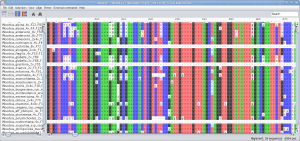BLAST and FastA: FastA and BLAST are two different tools. FastA searches for similarities on the European Bioinformatics Institute’s website, while BLAST is a tool for basic alignment. BLAST, FastA, and other software are widely used to compare DNA, amino acids, and proteins of different species, as well as nucleotides and nucleotides.
These algorithms were designed with speed in mind. Scientists were able to isolate DNA in the lab in the mid-1980s. This created a need for comparing and finding identical genes at high speeds. This two software have been designed so that users can quickly search for similar sequences to their query sequences.
BLAST stands for Basic Local Alignment Search tool and compares the two sequences using a localized approach. FastA refers to Fast A, where A stands as All. The software uses alphabets such as Fast A for DNA sequence and Fast P protein. Both BLAST (for genome databases) and FastA (for protein databases) are extremely fast at comparing them and, as a result, are very cost-effective and time-saving.
What is BLAST?

BLAST, a bioinformatics program developed in 1990, is now one of the most widely used. It is now available for everyone on the NCBI website. This software is also available to anyone. BLAST requires input data in FastA format. It gives out data in plain-text, HTML or XML formats. BLAST uses a search for localized similarity between two sequences. It then shortlists the sequences that are similar, and searches for neighbouring similarities.
This software will search for local regions that are similar and give a result when it reaches a certain threshold. This process is different from earlier software that searched the entire sequence and then did the comparison. It took a long time.
BLAST is not only used to check for similarity, but also has other applications, such as DNA mapping, comparing identical genes between species, or creating a phylogenetic chart.
What is FastA?

FastA is an alignment software for protein sequences. David J. Lipman, William R. Pearson, and others described this software back in 1985. The original version of the software could only compare protein sequences, but a modified version was able to compare DNA sequences. This software works by comparing two sequences using a statistical method. Local sequence alignment is used to match one DNA or protein sequence with another.
It does not always find the best match. This software can also produce mismatches because it compares localized similarities at times. FastA matches k-tuples (small parts of a sequence) with the k-tuples in the other sequence. When it reaches the threshold value at the end of the match process, the result is produced.
What are the similarities between BLAST and FastA?
- BLAST, FastA, and other bioinformatics programs are used to compare DNA and protein sequences.
- Both programs also use a scoring system to compare the sequences.
- Both tools provide highly accurate results.
Difference between BLAST and FastA
BLAST can be used to compare biological sequences. FastA, on the other hand, is another program that facilitates similarity checks of DNA and protein sequences. BLAST is more popular than FastA because it provides faster and more accurate results. This is the main difference between BLAST and FastA. Unlike FastA, BLAST can be modified to suit the needs of the user. This is another difference between BLAST and FastA.
| Feature | BLAST | FastA |
|---|---|---|
| Algorithm | Uses a heuristic algorithm to find significant sequence similarities in a database | Uses a dynamic programming algorithm to align a query sequence with sequences in a database |
| Types | BLAST has several types including blastn, blastp, blastx, tblastn, and tblastx | Only one type |
| Speed | BLAST is generally faster than FastA | FastA is generally slower than BLAST |
| Sensitivity | BLAST is less sensitive than FastA in detecting distant homologies | FastA is more sensitive than BLAST in detecting distant homologies |
| Outputs | BLAST provides several outputs including pairwise alignment, multiple sequence alignment, and graphical representation of hits | FastA provides pairwise alignment and score |
| Database search | BLAST requires a pre-built database to search against | FastA allows searching against a single sequence or a small set of sequences |
| User-friendliness | BLAST is considered more user-friendly than FastA | FastA is considered less user-friendly than BLAST |
Key difference:
Both BLAST and FASTA are widely used bioinformatics software tools for searching and comparing sequences. There are some key differences, but they also share many similarities. Here are the key differences between FASTA and BLAST:
Algorithmic Approach
- BLAST: BLAST uses a heuristic method to break down long sequences into shorter segments, called seeds or words. It looks for segment pairs with high scores (HSPs), between the query sequence and target sequence, and then extends these to find alignments.
- FASTA: FASTA is a faster but more sensitive algorithm that uses the Smith-Waterman Algorithm, which compares all possible subsequence alignments. FASTA is therefore more accurate at detecting subtle sequence similarity, but slower than the BLAST algorithm.
Speed and Efficiency:
- BLAST: Due its heuristic method, BLAST tends to be faster than FASTA. This is especially true for databases with larger sequence lengths and larger databases. This speed is achieved by sacrificing some sensitivity.
- FASTA: FASTA has been known to be slower because it compares every possible alignment. This is the preferred method when higher accuracy and sensitivity are required, but speed isn’t a major concern.
Database Search Options:
- BLAST: BLAST provides various flavors, such as BLASTn (nucleotide-nucleotide), BLASTp (protein-protein), BLASTx (translated nucleotide-protein), and more. Each flavor is optimized to search for specific types of sequences, allowing users targeted searches.
- FASTA: FASTA is primarily focused on comparing nucleotide or protein sequences. BLAST is more specialized, but it does not offer as many different options for specific types of sequences.
Output Format:
- BLAST: BLAST generates output typically in a tabular form known as the BLAST Report, which contains detailed information about alignments, scores, and statistics.
- FASTA: FASTA produces a pairwise aligned output that highlights the aligned region between the query sequence and the target sequence, along with the associated scores.
Availability and User Interfaces:
- BLAST: The BLAST suite of tools is widely available, both as standalone command line tools (e.g. BLASTn and BLASTp), as well as web-based interfaces such as NCBI-BLAST which offers an easy-to-use web interface for searching sequences.
- FASTA: FASTA can be used as standalone command line tools (such as FASTA36 or SEARCH) and as web-based interfaces such as EMBL-EBI FASTA searches.
Comparison Chart:
| Feature | BLAST | FASTA |
|---|---|---|
| Algorithmic Approach | A heuristic algorithm based on seeds | Smith-Waterman algorithm |
| Speed | Faster due to the heuristic approach | Slower but more sensitive |
| Database Search Options | Various flavors for different sequence types | Primarily focused on protein/nucleotide |
| Output Format | Tabular BLAST report | Pairwise alignment output |
| Availability | Standalone tools and web interfaces | Standalone tools and web interfaces |
| Specialization | Different flavors for specific sequence types | Generalized protein/nucleotide search |
| Sensitivity | Sacrifices sensitivity for speed | Higher sensitivity, more accurate |
Choosing the Right Tool: Differences Between BLAST and FASTA
When it comes to choosing the appropriate instrument for searching for sequence similarities and understanding the difference between both BLAST as well as FASTA is vital. BLAST along with FASTA are popular bioinformatics tools to compare biological sequences, however, their unique features and techniques allow them to be more appropriate for specific kinds of analyses. Let’s take a closer look at the factors to consider when choosing the right tool for the research requirements of your organization:
BLAST (Basic Local Alignment Search Tool):
- Large databases: BLAST can be ideal to search large databases due to its heuristic approach as well as indexing methods. If you’re working on large sequence databases, like protein databases or whole-genome databases, the speed as well as effectiveness shine.
- Quick Searches: BLAST was created to facilitate rapid sequence search. If you’re looking to conduct fast searches with moderate accuracy, BLAST’s heuristic algorithms can deliver results in a very short amount of time.
- Database Resources: BLAST includes the built-in NCBI databases which are regularly updated. This helps in the search process and makes sure you’re able to access the most recent sequence data.
- Functional Annotation: In the event that the goal is to note functional information for sequences, the ability of BLAST to recognize homologous sequences may give insight into possible functional affinities.
FASTA:
- Customizable Scoring Matrixes for Scoring: FASTA offers greater flexibility when selecting or creating scoring matrices. This is especially useful in the case of domain-specific expertise or requires a custom scoring method for your specific research.
- Comparative Genomics: If you’re interested in Comparative Genomics or studying the evolutionary connections between sequences, FASTA’s pairwise align method is useful in discovering the conserved regions and motifs.
- Local Databases: FASTA is a great option in the case of smaller, custom-designed local databases. If you’ve got curated data or specific sequences, FASTA’s capability to efficiently search local databases could be beneficial.
- Particular Motif Recognition: FASTA’s sensitivity as well as its concentration on local alignments makes it a great option for identifying particular motifs or shorter preserved regions in sequences.
General Considerations:
- Sequence Length: BLAST’s approach is better suitable for longer sequences however FASTA’s approach of pairwise alignment is more appropriate for shorter sequences, or in particular regions.
- The ability to scale: BLAST may become slower when it grows in size as the amount of data grows however FASTA’s speed is more constant.
- Statistical Significance: Both instruments offer statistical indicators, however, the meaning of these metrics could differ a bit. Knowing the significance of the value of the tools is crucial.
- User Experience: BLAST provides user-friendly interfaces, particularly in online searching, which makes it accessible to researchers with different levels of bioinformatics knowledge. FASTA typically requires more experience with command-line programs.
The decision of BLAST and FASTA is based on the nature of your research goals and the size of sequence databases as well as the desired sensitivity and the degree of customization needed. If you want to perform quick searches on massive datasets, BLAST will be typically the preferred option. If you are looking for custom-designed queries, comparative genomes, and motif recognition FASTA’s flexibility and its local alignment method may be better suited. It is worth looking at the tools and their capabilities in order to make sure that the sequence-related search produces accurate and relevant results.
Conclusion
FASTA and BLAST are pairwise alignment tools that are used in bioinformatics to search for similarities between DNA sequences or protein sequences. BLAST is widely used for local alignments of nucleotide sequences and amino acids. FASTA uses words or sequence patterns to search for similarity.
It is most suitable for searches of similarity between sequences that are less similar. The primary difference between BLAST and FASTA lies in the search strategies that each tool uses to find similar sequences.